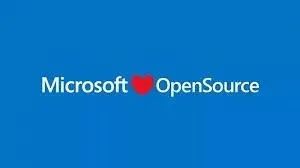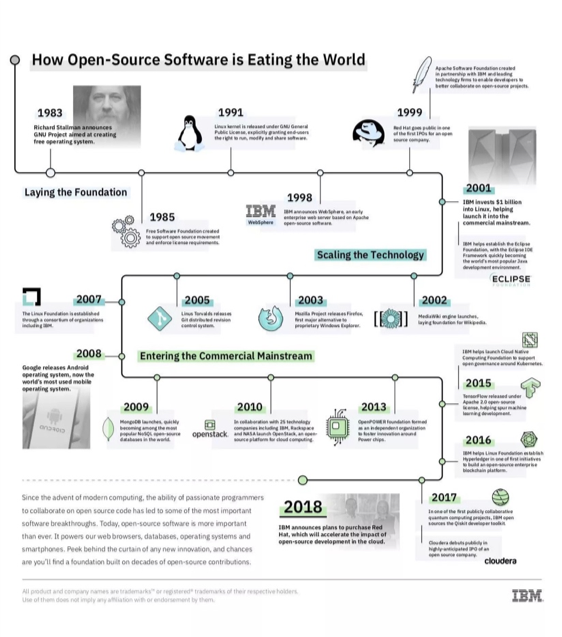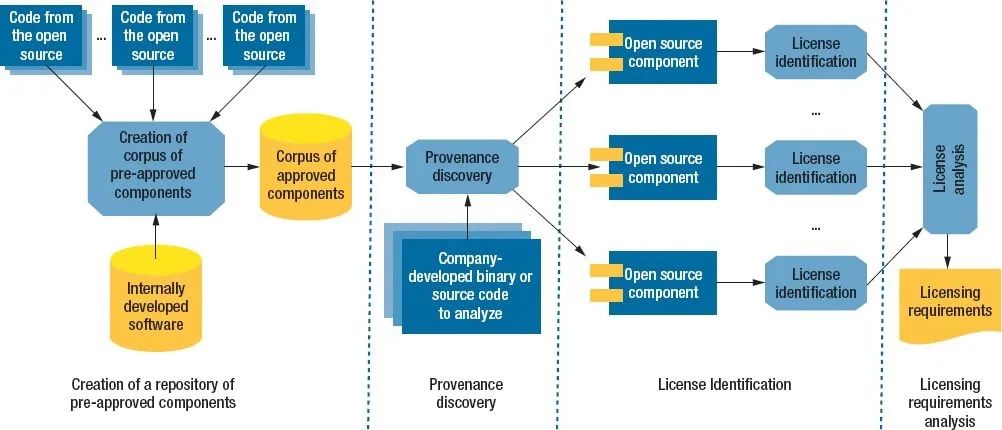|Author: Wang Xuan
|Reprinted from: PUPU Talk
|Editor: Wang Yuemin
|Designer: Liu Yingjie

Introduction of Kaiyuan News Agency
Open source is a new development mode, which has indeed solved some problems of technology and product prototype startup, cost, quality, update iteration time, and early user expansion for many start-ups at the source.
However, open source is not only an aid to entrepreneurship, but also an important opportunity for various enterprises and even for social, national and global economic transformation. In addition to the traditional enterprise led capitalism and the state led socialism, the sharing economy (doctrine) may emerge or even stand in a tripod, and the open-source movement has been the main foundation in the sharing economy.
On the issue of open source license, the Open Source Agency has long focused on open source governance (including risk governance, project governance and community governance). It is also the only member of the Open Source Initiative (OSI - Open Source Initiative) in China. At present, many open source licenses certified by OSI can solve many legal risk problems. At the same time, many new licenses are still being certified in succession. The Mulan Loose License (v2) recently launched in China and passed the OSI certification is the best example. At present, many open source licenses for Internet and public cloud applications have been or are being launched. The public cloud may have the opportunity to gradually solve the problem of enjoying its success without feedback.
Open source led cloud computing, big data, artificial intelligence, blockchain, Internet of Things and other new technologies will change human life. Whether teenagers will eventually become dragons is a more far-reaching long-term battle issue, and open source is one of the possible answers!

In 2020, the global situation will change, the capital market will rise and fall, and the economic crisis is imminent. Startup companies will no longer face the problem of how to develop, but life and death. financing (capital tightening) user (User bonus disappears) Commercialization (Customer resources are scarce). These three mountains in front of entrepreneurs are like the top of the mountain, which is daunting. This is both the worst and the best years, Open Source A new revolutionary force is coming quietly. It is about to ignite a spark on the grassland of science and technology entrepreneurship, illuminate the way forward, and finally form a prairie fire, profoundly changing the future of mankind.
Most good programmers do programming not because they expect to be paid or praised by the public, but because programming is really fun.
——Linus Torvalds 。
In the past decade, there have been three types of entrepreneurship: Cao Cao type, Sun Quan type and Liu Bei type. Open source is the fourth type and Liu Bang type.
There are three main entrepreneurial models in the past decade.
The first is to focus on a track, and then form a star team with technology, contacts, and financing channels. Then recruit people, spend heavily on land, quickly expand the market, defeat all competitors, and go public in just 2-3 years. We can call this model "Cao Cao type". The key to success lies in adequate food and grass (capital). Typical winners have to fight for more, Ruixing (measured by listing), and losers have OFO.
The second is to start from an actual demand scenario, where several like-minded entrepreneurial partners work together to polish technology, deepen business, consolidate products, steadily develop step by step, gradually increase the number of users, and then reach a critical stage to enter the outbreak period with the help of capital. We can call this model as Sun Quan type. The key to success is commercialization (liquidity). The winners have quick hands, and the losers have public comments.
The third is the combination of the first and the second. The first is to go online in a low-key manner, explore development, and then the market situation suddenly changes, the wind rises, and the opportunity is identified to get involved in the market war. According to the changes, quickly adjust the direction and strategy, and win the first place in the cruel competition of thousands of troops. This flexible adjustment model can be called Liu Bei type. The key to success is to adapt to market changes. There are Didi, Meituan and losers who are easy to get.
These three models are all successful paths that have been repeatedly verified by the market in the golden entrepreneurial era from 2010 to 2020. However, in 2020, which is a hell of a start, the past experience has been shattered. Today, entrepreneurs have three mountains: financing (capital tightening), users (the disappearance of user dividends), commercialization (the scarcity of customer resources). The difficulty of entrepreneurship is almost suffocating.
In this critical age of survival, entrepreneurship requires not only the courage to burn the boat, perseverance, but also the wisdom to plan strategies. It can skillfully avoid the mountains and fight in a circuitous way. Sun Tzu's Art of War says, "It is also the way of generals to defeat enemies, plan for dangers, distance and distance.". We can call this fourth mode of finding a way out of difficulties and hardships Liu Bangxing. The key to success lies in the entrepreneurial mode: finding a way that does not require painstaking efforts to find entrepreneurial teams, does not need to work behind closed doors to polish products for a long time, does not need to worry about early seed users, and does not need to run around every day, There is no need to rely solely on financing to survive.
Past and present life of open source: the brave fight against the dragon
The history of open source is a magnificent epic
Open source, generally speaking, is open software source code for all developers to learn and use. This is the free and open values pursued by the first batch of Internet creators, and it is also the ultimate dream of all software engineers.
Without looking back at history, we cannot look forward to the future. In order to better understand the open source model, let's spend a few minutes to trace the past and present life of open source.
Throughout the history of open source, it is a legend of brave men fighting against evil dragons. The brave are start-ups, and the dragon is a monopoly giant. During this period, there were many ups and downs, just like a magnificent software epic.
Time goes back to 1975. The first product of Microsoft, Basic programming software, was well received. At that time, software users were all developers, and it was natural to open source code, so many people copied Basic for research or work without authorization, which made Bill Gates very angry and wrote a letter to denounce it as plagiarism, The letter was titled "Open Letter to Computer Lovers", which is very famous in history. Gates broke with the majority of developers from then on, forming two camps of closed source and open source, and Microsoft became the first dragon in the history of open source.
Throughout the 1980s and 1990s, Microsoft was a public enemy in Silicon Valley. The Windows operating system bundled IE, defeating Netscape and other companies representing the technological strength of Silicon Valley. The heavy barriers built by a large number of patents also made the development of engineers at that time extremely difficult. At the same time, the giants also saw the value of open source software. After the maturity of Unix, which was developed by many open source engineers, AT&T directly took it into private ownership and charged high licensing fees (which also led to the decline of Unix), which made the public dare not speak up.
Against this background, in 1983, Richard Stallman, an American, established the operating system GNU (GNU's Not Unix), marking the concrete landing of the idea of open source, and soon formed a vigorous open source movement. In 1989, Stallman presided over the drafting of the GNU Agreement, which clearly put forward the idea of anti copyright. In 1991, Finnish Linus Torvalds released GNU/Linux based on the GNU GPL framework, marking the birth of the open source system Linux. In 1998, the Open Software Initiative created the term "Open Source", which has continued to this day.
During this period, many engineers supporting open source likened themselves to the Free Rebellion Alliance in Star Wars, fighting against the evil monopoly empire. However, the power of open source at that time was very small compared with the giant companies. The development of the first generation of open source companies is very difficult. RedHat and Microsoft, MySQL and Oracle, XenSource and VMWare are just like grass and giant trees competing. After all, open source and commercialization contradict each other. A famous question is: if the source code of software can be obtained for free, how can programmers make a living? At that time, the industry agreed that open source software was a low value commodity and could never reach the economic value of closed source companies.
However, with the rise of the Internet, the second generation of open source companies, represented by Google, were born and finally broke the dominance of the giants for 30 years.
Different from the early Free Rebellion, Google bypassed the main battlefield of the desktop and made efforts on the mobile end. In 2007, it opened the Android system, making the Microsoft Windows platform no longer the dominant giant. In terms of business strategy, Google tried a very smart strategy, which only started the AOSP part (Android Open Source Project), The charge is Google Mobile Service, Google's mobile service. GMS is Google's various applications and APIs, including maps, mailboxes, YouTube and app stores that we are familiar with. It is a real money printer.
From open source Chrome browser, Android system, to deep learning framework Tensorflow and other technologies, as the largest contributor and beneficiary of software technology development in the past decade, open source is one of Google's most important business strategies. The value-added closed source code is placed on the open source software. Only part of the software in the project is licensed for free, and the cost of using the closed source software that exceeds the value can be charged to customers according to the commercial license.
Under the impact of the new generation of open source power, the old generation of Dragon Microsoft had to hold its head high and publicly claim to embrace open source. The new CEO Satya Nadella even shouted "Microsoft loves Linux", which formed a sharp contrast with the former CEO Steve Ballmer's wild statement that "open source is a cancer".

The old dragon is gone, and the new dragon is born. Through the network effect and huge user base of the software, Google has finally had to regard it as a standard configuration for mobile phone manufacturers, allowing Google to continue the "high profit, closed source and exclusive" business model from the IP world, and establish its dominance in mobile operating systems. Just as Microsoft bundled IE, Google also used this monopoly position to require mobile phone manufacturers to bundle and install Google products, which deviated from the original ideal of the Free Rebels. This monopoly has also become a weapon of the US government against Huawei.
This is a story about a teenager who eventually turns into a vicious dragon.
However, the tide of history is surging, and the third wave of open source revolution is brewing, which will cause great waves in the near future.
In 2008, a new generation of revolutionary seed GitHub open source community was born. It is an open source distributed version control system that allows millions of developers around the world to participate in open source projects, contribute to collaborative code writing, and build SaaS services through open source projects.
In a sense, GitHub has profoundly changed people's understanding of programming. Today, almost all programmers can not do without it, or upload their own open source projects, or find like-minded partners, or just go to learn the code of God.
Different from the early predecessors of open source, GitHub is extremely successful commercially. On the premise of almost no financing, advertising, and spending money to buy users, GitHub has gathered 40 million developers, 3 million organizational accounts, and 44 million repos around the world, and was acquired by Microsoft for $7.5 billion in 2018.
Back in 2008, when MySQL was acquired by Sun Microsystems for $1 billion, the market was convinced that $1 billion represented the largest revenue that any open source company could obtain. This price record has been maintained for many years and is regarded by the software industry as the unprecedented value of open source companies.
Although open source has brought unprecedented technological innovation, the market has not found its potential commercial value for a long time, until the rise of cloud computing and SaaS, open source has finally moved from technological innovation to business model innovation.
In 2014, Google officially opened the new generation cloud computing container K8S (Kubernetes) and then handed it over to CNCF under the Linux Foundation. This landmark event not only means that Google has come from behind to compete with Amazon for the public cloud market, but also that the idea of open source has been deeply rooted in the hearts of the people. If there is a debate between closed source and open source in the old technology era of Microsoft's operating system, open source will dominate the world in the emerging cloud era.
The result is a huge increase in the commercial value of open source. Cloudera, MongoDB, Mulesoft, Elastic and GitHub are all IPO or M&A with billions of dollars. Of course, Red Hat sold to IBM at a sky high price of 34 billion dollars. I believe that in the future, there will be more and more new records.
This series of successful cases is no longer the recognition of open source itself, but marks the gradual revival of its model and value as a commercial activity, and finally won widespread praise in the capital market.

Why open source: low investment, low threshold, low risk, high return
Open source has incomparable advantages in entrepreneurship
As an entrepreneur, before taking action, four points must be clearly thought out: team, fund, product and market are indispensable. Specifically, it is to establish a reliable entrepreneurial team, obtain angel or round A financing, develop products with core competitiveness, and find initial seed users.
When the market environment was good a few years ago, none of this was a problem. But in today's economic situation, a large number of small and medium-sized companies are on the verge of bankruptcy and eager to save themselves. Listed companies are downsizing on a large scale, and investment institutions have a difficult task of raising funds themselves. Even persuading friends to resign and work together has become an extravagant hope. Starting a business in a traditional way is simply a hard version of customs clearance.
At this time, the advantages of open source projects are fully reflected.
First, in an open source community, it is easier for entrepreneurs to find like-minded partners. In the traditional mode, people prefer to find experts from big factories, or talents with high educational background, or simply their classmates and friends. But in fact, the really outstanding partners are people who have the same values, have a deep understanding of products, and are enthusiastic. Such talents are hard to meet in reality, but they can be found everywhere in the open source community, as long as you are willing to dig.
Secondly, as an open source project, angel investment is not required in the early stage, or even capital maintenance is not required for a long time, because all open source work is free, documentation, development, Bug repair, testing, version iteration, which in traditional companies need to consume a lot of manpower, material resources and financial resources, have been quietly completed by various experts. Of course, all these also depend on your efforts in the project, but money has never been the main focus of the open source community.
Moreover, compared with closed source software, the quality of open source products is more stable and reliable. This is because the developers of closed source software are good and bad. In order to make money, they often rush to work, and it is difficult to ensure stable output. However, the open source community usually has experts from all walks of life to maintain. They work with enthusiasm and strive for product excellence. In addition, there are many active open source project participants, and a steady stream of developers pay attention to and feed back bugs. The risk is lower, The quality is also more guaranteed.
Finally, a good open source project will naturally attract a group of loyal seed users to use it. If this product can solve the core problems and improve productivity, it will greatly increase the attention in the open source community, attract the participation of real gods, form a good reputation and user goodwill, and even arouse the interest of major companies, organizations and investment institutions, You don't need to advertise for marketing, you can win the market and bring users.
In recent years, the rise of cloud computing has opened a new door. Cloud computing may be the best choice for open source companies to achieve commercialization. In the SaaS business model, open source companies repackage and encapsulate open source projects and directly provide them in the form of cloud services. At the beginning, they used open source software as infrastructure, but users did not know or care whether it was open source or closed source, which led to similar estimates of the two, and also improved the business value of open source companies invisibly. Of course, this approach has also led to the confrontation and competition between open source companies and cloud vendors, which we will discuss later.
Different from the traditional model, the core of open source entrepreneurship is not the technology itself, because the technology is not exclusive, but the organization and management of open source projects according to needs, and the provision of enterprise level services (such as the famous MongoDB), or consumer services (such as the MIUI started by Xiaomi), and because of the large number of developers behind, It can provide customers with better technology updates and never have to worry about software obsolescence.
Take an inappropriate metaphor. Closed source companies are like building cars behind closed doors. Before the cars (products) are built, no one knows whether they can really go on the road (market). Open source companies are much simpler. The cars have long been popular and have been used many times in the test field (open source community), so people don't need to reinvent the wheels.
Of course, there is no free lunch. Open source projects also have many difficulties and risks.
In the early days of open source, copyright was the number one killer of many developers. We worked hard to develop a project, but someone could take the source code for commercial use, which was really chilling. At that time, AT&T privatized Unix, which caused a great uproar in the open source world. However, it is precisely in view of this that various open source licenses are born and emerging in endlessly. From the legal perspective, the license is a contract signed by both parties, which has legal effect. However, in the actual application process, it is difficult to investigate the violation of the contract, and there is no particularly good solution so far.
Software licensing is a hotly debated topic. Copyright is a kind of monopoly in essence, but open source cannot do without copyright. Is this contradictory to free sharing? The permit is becoming more and more complex, will it become a fetter in the future? These value judgments with a bit of philosophical meaning are difficult to distinguish between right and wrong, so we can only take one step at a time and leave it to future generations to solve.

On the other hand, although the rise of cloud computing has brought commercial prospects to open source companies, it has also created a new competitor, that is, cloud vendors.
Eliot Horowitz, CTO of MongoDB, once said, "The market is increasingly consuming software as a service, creating an incredible opportunity to cultivate a new round of great open source service software. Unfortunately, once an open source project becomes interesting, cloud vendors who do not develop the software will easily seize all the value, but do not make any contribution to the community. ”
It can be seen that if the commercialization of open source reaches a certain maturity, the threat of public cloud may emerge.
In fact, we might as well consider whether the threat from public cloud providers has been over considered. Although these providers may host open source projects, so far, no open source company has been completely replaced by cloud providers.
For this question, PUPU talk interviewed Wen Ming, the founder of APISIX, and asked how to compete with the cloud factories of Internet giants. Wen's answer was as follows:
"The public cloud uses open source projects, no problem. But the public cloud will also do hybrid cloud deployment, private solutions. The public cloud uses our open source products, and private solutions will also be packaged. Because we are not familiar with open source products, this big factory is not good at it, so this part of the cake will be left to us."
In fact, this answer can go back to why the open source model can be so powerful. Independent open source companies have three major competitive advantages:
-Enterprise customers do not want to bind cloud service providers.
-The customer wants to buy from the person who wrote the code.
-Cloud service providers do not have the same depth of project understanding as open source companies.
When these three things are combined, it is the real core competitiveness, which is why we haven't seen the large cloud factories completely replace independent open source companies.
At the same time, it is more important to be the leader and definer of the category (for example, no Hadoop company can define this category separately). For open source companies, the most important thing is to take the lead in front of big factories, so that everyone knows that this technology is led by you. The lack of IT ability of Chinese enterprise customers determines that it is not enough to be the first in a single category, but also needs a complete solution to achieve advantages.
At the same time, in essence, the hosting mode of open-source companies is the same as that of cloud manufacturers, except that computing resources are still grafted on the public cloud. Whether the hosting mode can work depends on how good compliance and data privacy can be, or customers will not dare to release data, even if they actually trust the technology.
In recent times, Zoom was beaten and bombed by security incidents, and its reputation in the media fell to the bottom, with its share price dropping nearly 30 dollars. In fact, as an open source Chinese cloud service enterprise, customers will only trust it if they make 200% efforts.
The general trend of human technology development
The global open source industry has taken shape, and there are unlimited opportunities to nurture it
In the new era caused by the epidemic and the trend of anti globalization in western countries, the economic situation may not be particularly improved in the foreseeable future. Reflecting on the Internet era, open source is undoubtedly a more efficient, more lasting and more business logical entrepreneurial model than the model of burning money to encircle the land. As mentioned above, for start-ups, open source is a way of survival that does not require painstaking efforts to find entrepreneurial teams, do not need to polish products behind closed doors for a long time, do not need to worry about early seed users, do not need to run business every day, and do not need to rely entirely on financing to survive.
More importantly, open source is not only a way to solve technical problems, but also a major trend of human technology development. It will not only be built in the small circle of software and the Internet, but also in firmware, hardware and other ecosystems, and the business model will become clearer and clearer.
In 2019, the China Academy of Information and Communication Technology (CAICT) released the White Paper on Open Source Industry, which surveyed nearly 90 cities in 24 provinces across the country, including Internet, government, finance, medical care, software and information technology services, manufacturing, telecommunications, transportation and logistics, science, education, culture, health and energy. The proportion of enterprises that have applied open source technology in China has reached 86.7%, 10.6% of enterprises plan to apply open source technology. Open source technology has been widely accepted by enterprises, and the industrial chain has taken shape.
Today, almost all high-tech companies in the world, whether Facebook Google 、Amazon 、Apple , Tencent, Alibaba, Baidu and Huawei are all using open source software as their technical backing to build their own open source projects more and more. Baidu has more than 700 open source projects, Ali has 1200, and Google has more than 2000.
In the future, open source will not only make achievements in software and data fields, but also play a role in hardware, such as AI robots, intelligent devices, the Internet of Things, security, medical health and other fields that cannot be realized by traditional software. The future open source companies will no longer be RedHat, Elastic, Databricks and Cloudera, but Facebook The top technology companies at Google, Amazon, Apple level and all kinds of high-quality projects on GitHub will be excavated, realized, and diffused, gradually forming a situation of starting a prairie fire, and finally converging into a new generation of technological revolution, profoundly changing the future of human society.
Open source, let's wait and see.
Introduction to Kaiyuan News Agency
The Open Source Society is a manufacturer neutral, volunteer and non-profit open source alliance organized by enterprises, communities and individuals at home and abroad who support open source in accordance with the principle of "contribution, consensus and co governance", aiming to jointly create a healthy and sustainable open source ecosystem and promote the Chinese open source community to become an active participant and contributor of global open source software. We focus on open source governance, international integration, community development and open source projects.
Related reading | Related Reading

How can the 2020 Development Ceremony in the summer get fewer big shots from the Open Source Agency?

Open source can only make friends?

Talking about the spirit of contract from MIT agreement
If you like the content of this article, please give us a look





















